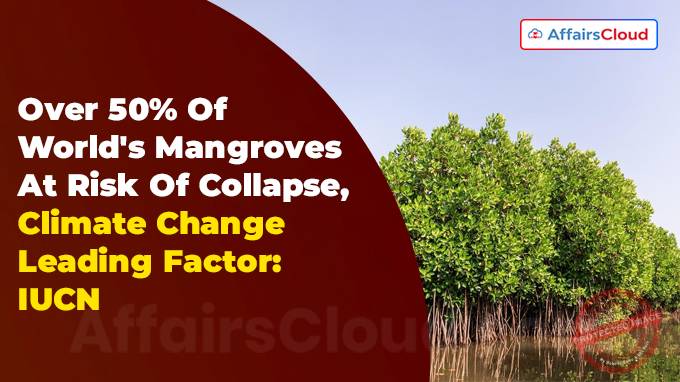 According to the International Union for Conservation of Nature (IUCN)’s Red List of Mangrove Ecosystems, over 50% of the world’s mangrove ecosystems are at risk of collapse, with nearly 1 in 5 faces severe risk.
According to the International Union for Conservation of Nature (IUCN)’s Red List of Mangrove Ecosystems, over 50% of the world’s mangrove ecosystems are at risk of collapse, with nearly 1 in 5 faces severe risk.
- As per the study, climate change poses serious threats to 33% (1/3rd) of the mangrove ecosystems across the world.
Significance:
i.This is the first global mangrove assessment for the IUCN Red List of Ecosystem(RLE), a global standard for measuring the health of ecosystems.
ii.This is the first time an ecosystem group has been assessed entirely across the earth using the IUCN Red List of Ecosystems.
iii.This classified the world’s mangrove ecosystems in 36 different regions called provinces and assessed the threats and risk of collapse in each region.
iv.The study is led by IUCN with participation of more than 250 experts and in 44 countries.
Overview:
i.50% of the world’s mangrove area are listed in the IUCN list under threat categories of Vulnerable (VU), Endangered (EN), or Critically Endangered (CR). The rest are listed under the categories of Near Threatened (NT), Least Concern (LC) or Not Evaluated (NE).
ii.Approximately 20% (19.6%) of the assessed mangroves are at severe risk and have been marked as Endangered or Critically Endangered.
iii.The study classified the mangrove ecosystems of: South India, Sri Lanka, the Maldives and North West Atlantic as Critically Endangered.
Threats:
i.The mangrove ecosystems cover about 150 thousand meter square along tropical, sub-tropical and some warm temperate coasts of the world. About 15% of the world’s coastlines are covered by mangroves.
ii.Increased frequency and intensity of cyclones/typhoons/hurricanes and tropical storms impact mangroves on some coastlines.
iii.Sea-level rise is one of the main threat affecting mangrove ecosystems. Around 25% of the global mangrove area is predicted to be submerged in the next 50 Years.
- Regions like: The Northwest Atlantic, North Indian Ocean, Red Sea, South China Sea, and Gulf of Aden coast will be severely affected.
iv.The study outlined various factors that pose a serious threat to mangroves: Deforestation, Development, Pollution and Dam Construction.
Economic and Social Importance:
i.If 50% of the mangrove ecosystem is lost, around 1.8 billion tonnes of carbon stored (16% of the total carbon stored in mangroves), currently valued at USD 13 billion, will be lost by 2050.
ii.The study observed that by maintaining mangrove ecosystems across the globe will play a pivotal role to mitigate the impacts of climate change.
iii.The study revealed that due to climate change and sea-level rise, about 2.1 million lives will be exposed to coastal flooding (at present, 14.5% of lives exposed to it) and USD 36 billion worth in protection value of properties (at present, 35.7% property values protected).
- Also, it will impact the 17 million days of fishing which accounts for 14% of current fishing effort supported by mangroves.
iv.The study cautioned that in absence of conservation efforts, about 7,055 square kilometres (approximately 5%) more mangroves will be lost and 23,672 square kilometres (approx. 16%) of these ecosystems will be submerged by 2050.
About IUCN Red List of Ecosystems:
This is the key to track progress towards the goal of halting and reversing biodiversity loss, in line with the Kunming-Montreal Global Biodiversity Framework.
About International Union for Conservation of Nature (IUCN):
Director-General (DG)- Dr. Grethel Aguilar
Headquarters- Gland, Switzerland
Establishment- 1948




